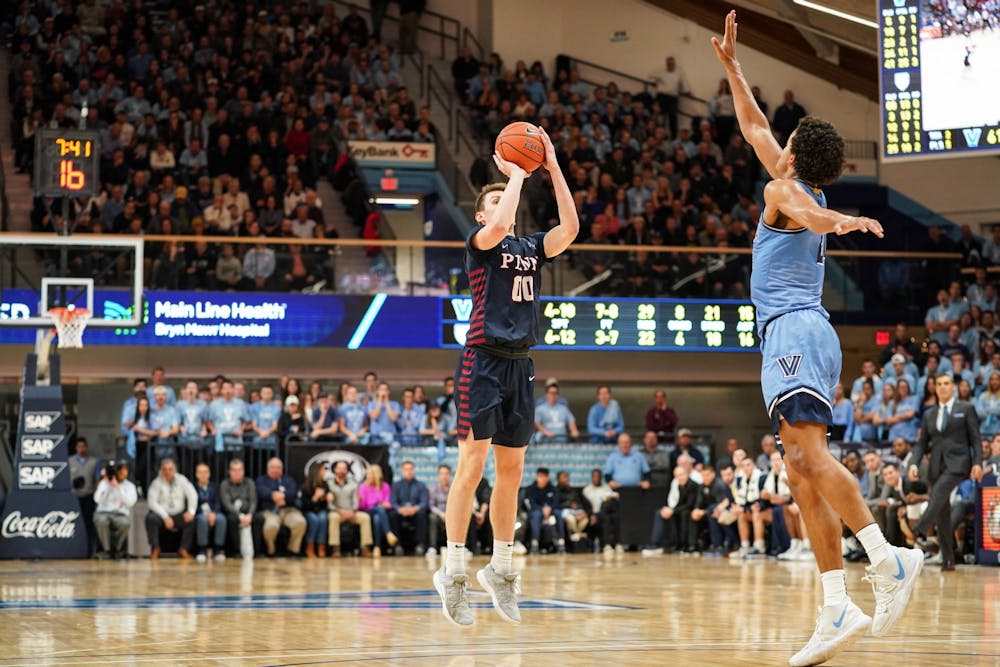Three points are better than two.
With the proliferation of the three-point shot extending through all levels of basketball, the NCAA has made a rule change to increase its difficulty. Beginning this season, the three-point line has been extended to 22 feet and 1¾ inches, up from the 20-foot, 9-inch line that was in place for the previous decade.
Small changes like this tend to result in a tangible initial effect — in this case lower three-point field-goal percentages — but an eventual stabilization. As a team, however, Penn men’s basketball has been unaffected by this change as they are currently shooting 35.2% from downtown, almost exactly the same as their 35.1% figure from last season.
The more significant changes have come at the individual level with individual players forced to make subtle adjustments in their games.
“I think it’s less of a team issue as it could be an individual issue,” senior guard Ryan Betley said.
In adapting to the new distance, players are conscious of “toeing the line,” or making sure that no part of their feet touches the three-point line. With this mindset, they initially tend to shoot from further away to make sure their made baskets will count as threes. Theoretically, this should negatively impact three-point percentages.
“Last year we weren’t as conscious of toeing the line as much as we are this year,” coach Steve Donahue said. “Early on [this season] we settled for longer shots.”
Donahue also pointed to corner threes as a whole different situation because there is such a small amount of floor space between the three-point line and the boundary. Players’ traditional footwork in that area doesn’t work anymore, as they are forced to pull up off of two feet instead of being able to gather more. They also risk accidentally leaving their heels out of bounds when they receive a pass in the corner, which could lead to more turnovers.
RELATED:
Papazekos | Despite pair of bad losses, Penn has shown it poses a problem for top teams
Penn men's basketball can't come back against No. 23 Villanova
Knock-down shooters like Betley, however, are often hounded by defenders all the way out to and even beyond the three-point line. The change in distance then does not affect their games too much, as they already have experience taking very long shots.

Freshman guard Jordan Dingle has notched 22 triples for the Quakers this season.
Three-point specialists also have more confidence in shooting from the increased distance, so they really aren’t making significant changes in how they play.
“I’m used to taking shots from that far normally,” Betley said. “I think it’s well within my range.”
Forwards and bigs, on the other hand, struggle to hit open threes, and the new line makes it even more difficult. Players who greatly improved their shooting ability last season could struggle to carry that growth over into this season.
From a defensive perspective, this makes those players easier to defend as they are less likely to venture out that far for their shot attempts. Even if they are willing to spot up from deep, they will, at least initially, have more difficulty sinking their shots.
The Quakers acknowledge that the new line could affect how they defend, especially concerning bigs, but their approach remains the same.
“What we’re trying to do doesn’t change; we’re trying to run shooters off the three-point line and make them shoot contested twos,” Betley said.
While this subtle change hasn’t shown up much in the stat sheet, it could have played a role in a game outcome already in this young season. As time expired in the first round of the Wooden Legacy, a potential game-tying three-pointer by Central Florida was ruled a two as freshman guard Darin Green Jr.’s toe was clearly on the line.
Last season, that shot would have likely been a three, and the Quakers would have gone to overtime against the Knights. Luckily for Penn, the new three-point line was there to save the day.









